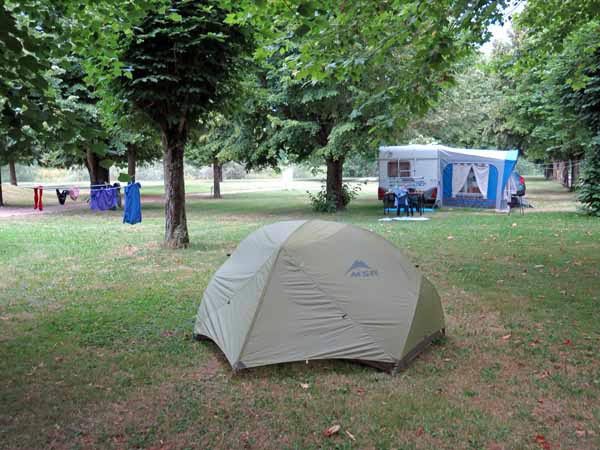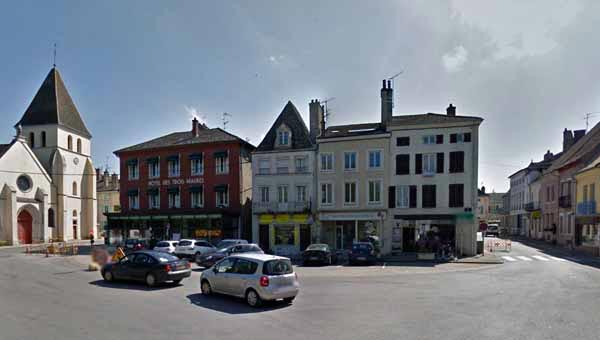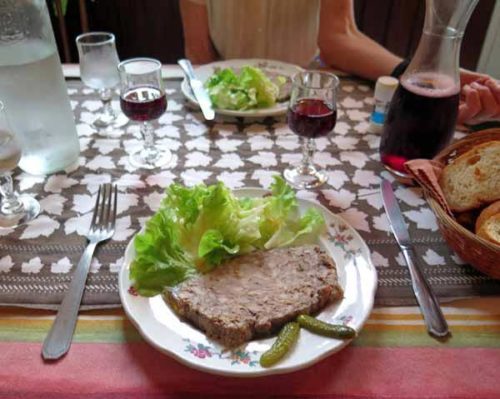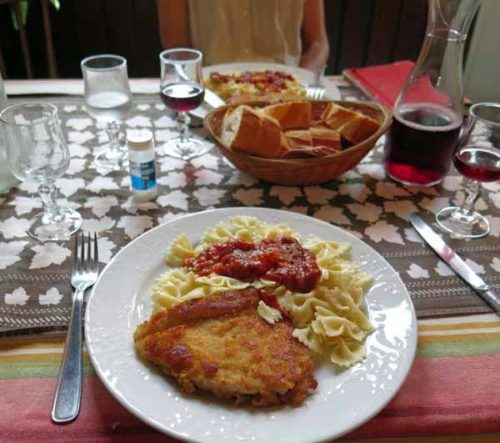
Monday, 26 June 2017
Distance 24 km
Duration 4 hours 50 minutes
Ascent 35 m, descent 33 m
Map 136 of the
As is our habit, we rose early and were almost ready to go when our Dutch fairy godmother popped her head out of her caravan and announced that she was making tea for us.
Miraculously, she had a supply of takeaway cups with lids, so with many expressions of gratitude, we took them off and sat down at a table outside the closed reception office. The cheese from last night made a good little accompaniment.
For the first and last time, we crossed the impressive Pont de Bourgogne, supported by fans of wires that looked as light as cobwebs from a distance, but up close were the size of rocket launchers.

On the other side of the great river, we found ourselves in a pleasantly landscaped park dotted with important-looking buildings and dissected by multi-lane roads.
We were looking for a bar, as we did not think tea and cheese really amounted to breakfast, and at the second roundabout, we saw a boulangerie that also had a coffee machine – a new trend in France, and a very welcome one to us, since boulangeries always open at the crack of dawn.
With the sun streaming in delightfully, we sat on tall stools at a heavy blonde wood table for a satisfying second breakfast of coffee, with pastries still warm from the oven.

After that we walked along the highway past apartment blocks and factories, whose ugliness was mellowed by groves of trees, until we came to the bridge over the Canal du Centre, where a longboat stood in the water as if trapped in glass.
This canal is only 112 km long but goes over the main watershed of France.
It was the first link between the Saône and the Loire, allowing cargo from the Atlantic to travel by barge all the way to the Mediterranean, via the Seine, the Canal de Briare, the Loire, this canal, the Saône and then the Rhône.
It was opened in 1792, just scraping in before the chaos of the Revolution put an end to many public works.
Half an hour later we arrived at Crissey without ever leaving the built-up outskirts of Chalon-sur-Saône.

Raw new warehouses and cottages had invaded what must have been farmland a few years earlier, but Crissey itself had a fine church and a few other old buildings, including the bar.
Naturally we stopped for a round of coffee, while across the road the local children were being put on the school bus.
After that we finally reached the limits of the urban sprawl and walked along a quiet little road through cropland, as flat as a lake. It was only
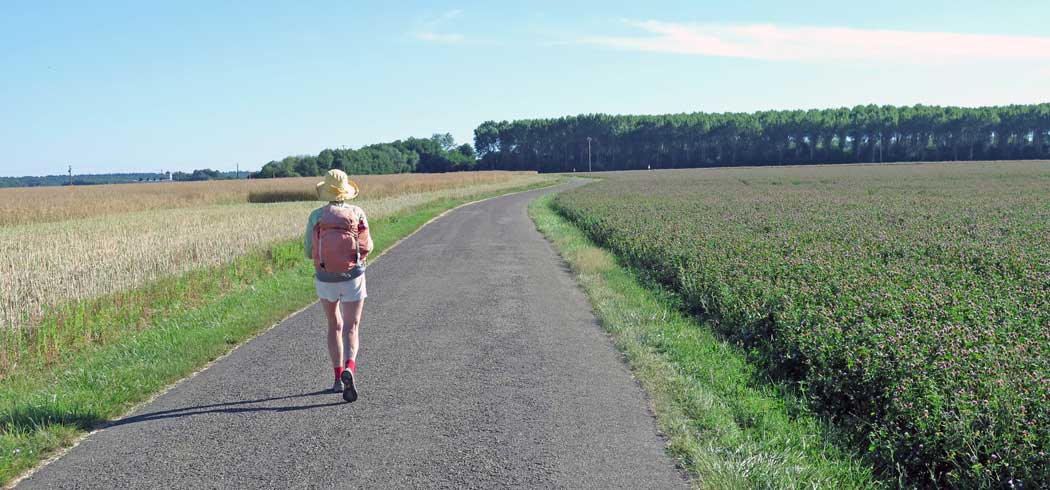
There was a dark patch of forest ahead and when we got near it, we found ourselves crossing an old railway line that disappeared into the shade of the trees.
It had a well-worn wheel track beside it, so we decided to leave the road and give it a try. It turned out to be a brilliant short-cut and a very pleasant, shady walk.
We crossed a couple of small roads before having to take to the scorching bitumen again as we approached the village of Gergy.
As we expected, there was a bar here too, and this one (le Café du Pont) had a beautiful terrace shaded by grapevines, where we ordered Oranginas instead of the habitual coffee. It was our fourth refreshment stop for the morning and we felt well enough caffeinated.

An old couple was sitting at the other end of the grape arbour, she small and stout in a skirt, with a walking stick, and he tall and rangy.
As they left they came over and asked us where we were going, advising us to ignore the “Route Barrée” (road closed) sign on the riverside path and to walk on without fear. They lived nearby, on the riverbank, they said.
From the bar, we descended on a tree-lined road to rejoin the river at a sort of recreation area, with sports fields and a small camping ground.
A minute later Tao and Brett, the Dutch-Australian couple whom we had met last night, came gliding up on their bikes, and we walked along together for a way.
To our surprise, we caught up with the couple from the bar (we had assumed they had come by car) and everybody was very happy, although the gay boys spoke no French and the local couple spoke no English. We were the go-betweens to the degree possible.
The old lady got us to listen to a high, fluting bird call, which she said belonged to a rare river bird. She told us its French name, and her husband supplied its German name (perhaps he was German), but we were none the wiser.
They turned off to their house at Montchanu, and the rest of us walked on together until we came to the “Route Barrée” sign, at which point our companions decided to obey, taking a bitumen path up towards the road, while we pressed on along the dusty track.

This became rougher and rougher as we went along. The grass was lank and dry, almost like in Australia, which was not what we had come to France to see.
Also, we were running out of energy, despite all the bars we had visited, and we were out in the full blast of the midday sun.
Eventually, we came to a bridge and rejoined the bitumen cycle track. At that moment Brett and Tao loomed into view, on the return leg of their little jaunt, their bare, burnished torsos gleaming in the heat.
We were able to tell them that they had done the right thing, sticking to the rules.
A couple of tiring kilometres beyond that (including a footbridge over the river Dheune as it emptied into the Saône), we finally arrived at the bridge over the Saône and beyond it the camping ground of the village.
The camping ground was on a long, low-lying point of land bordering the Saône, and there were plenty of caravans and tents scattered about among the trees. We did very little during the afternoon, happy to just lie about in the shade.
Late in the day a couple of cyclists cruised in and set up their tent not far from ours, so I went over and asked them if they were doing the Saône-à-Vélo ride.
They were not – they were heading for Dôle, Besançon, and maybe even Strasbourg, which sounded a long way to us. The woman had a slightly African look, although she was a native of Pau, and insisted on speaking English (which she did very well).
About
It is a very ancient settlement, and despite its present mild appearance, it has twice been on the front line of conflict. In mediaeval times, during the Hundred Years War, it was on the border between French and English territory and fortified accordingly. Then in World War II it was on the demarcation line between occupied and Vichy France.
In the main square, the hotel restaurant looked promising but was closed on Mondays, so we continued up the street, past the Café de Paris (how many of them are there in France?), to the next corner, where there was a large restaurant called le Soleil d’Or, with outdoor tables under awnings and some heavily lopped trees.
Fortunately, they were open on Mondays, but only the menu du jour was on offer. We did not mind. We took our apéritifs outside and told the waitress that we would dine outside also, but when the time came it was getting cool, so we asked to go inside.
There was a dining room behind the bar, with a dark, old-fashioned appearance. The rough-hewn stone walls that we admired at first turned out to be wallpaper, and there were mismatched tablecloths, chairs and rugs, but the atmosphere was pleasant.
Our fellow diners were a German couple whom we had seen earlier at the camping ground, three roughly dressed Spanish workers, and four young locals. Our table was next to the window, looking out onto the terrace.
The fixed menu began with a hearty slab of terrine, delicious with salad, gherkins and bread, and proceeded to crumbed chicken accompanied by pasta and a spicy sauce.
For dessert, Keith had Îles Flottantes, but I just had coffee. Meanwhile, our cyclist friends had arrived for an after-dinner drink and were sitting just outside the open window near us, so we were able to converse without rising from our seats.
On our way back to the tent we stopped at the Café de Paris to ask what time they opened in the morning, and the pleasing reply was
Further down the street, on the edge of town, was an illuminated sign telling drivers how fast they were going, and urging them not to speed. Out of curiosity we strode towards it and got the reading of
Previous day: Gigny-sur-Saône to Chalon-sur-Saône


